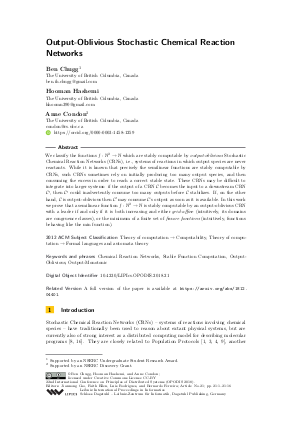Output-Oblivious Stochastic Chemical Reaction Networks
Authors
Ben Chugg,
Hooman Hashemi,
Anne Condon 
-
Part of:
Volume:
22nd International Conference on Principles of Distributed Systems (OPODIS 2018)
Part of: Series: Leibniz International Proceedings in Informatics (LIPIcs)
Part of: Conference: International Conference on Principles of Distributed Systems (OPODIS) - License:
 Creative Commons Attribution 3.0 Unported license
Creative Commons Attribution 3.0 Unported license
- Publication Date: 2019-01-15
File

PDF
LIPIcs.OPODIS.2018.21.pdf
- Filesize: 0.55 MB
- 16 pages
Document Identifiers
Related Versions
-
A full version of the paper is available at https://arxiv.org/abs/1812.04401.
Subject Classification
ACM Subject Classification
- Theory of computation → Computability
- Theory of computation → Formal languages and automata theory
Keywords
- Chemical Reaction Networks
- Stable Function Computation
- Output-Oblivious
- Output-Monotonic
Metrics
- Access Statistics
-
Total Accesses (updated on a weekly basis)
0Document
0Metadata
Abstract
We classify the functions f:N^2 -> N which are stably computable by output-oblivious Stochastic Chemical Reaction Networks (CRNs), i.e., systems of reactions in which output species are never reactants. While it is known that precisely the semilinear functions are stably computable by CRNs, such CRNs sometimes rely on initially producing too many output species, and then consuming the excess in order to reach a correct stable state. These CRNs may be difficult to integrate into larger systems: if the output of a CRN C becomes the input to a downstream CRN C', then C' could inadvertently consume too many outputs before C stabilizes. If, on the other hand, C is output-oblivious then C' may consume C's output as soon as it is available. In this work we prove that a semilinear function f:N^2 -> N is stably computable by an output-oblivious CRN with a leader if and only if it is both increasing and either grid-affine (intuitively, its domains are congruence classes), or the minimum of a finite set of fissure functions (intuitively, functions behaving like the min function).
Cite As Get BibTex
Ben Chugg, Hooman Hashemi, and Anne Condon. Output-Oblivious Stochastic Chemical Reaction Networks. In 22nd International Conference on Principles of Distributed Systems (OPODIS 2018). Leibniz International Proceedings in Informatics (LIPIcs), Volume 125, pp. 21:1-21:16, Schloss Dagstuhl – Leibniz-Zentrum für Informatik (2019)
https://doi.org/10.4230/LIPIcs.OPODIS.2018.21
BibTex
@InProceedings{chugg_et_al:LIPIcs.OPODIS.2018.21,
author = {Chugg, Ben and Hashemi, Hooman and Condon, Anne},
title = {{Output-Oblivious Stochastic Chemical Reaction Networks}},
booktitle = {22nd International Conference on Principles of Distributed Systems (OPODIS 2018)},
pages = {21:1--21:16},
series = {Leibniz International Proceedings in Informatics (LIPIcs)},
ISBN = {978-3-95977-098-9},
ISSN = {1868-8969},
year = {2019},
volume = {125},
editor = {Cao, Jiannong and Ellen, Faith and Rodrigues, Luis and Ferreira, Bernardo},
publisher = {Schloss Dagstuhl -- Leibniz-Zentrum f{\"u}r Informatik},
address = {Dagstuhl, Germany},
URL = {https://drops.dagstuhl.de/entities/document/10.4230/LIPIcs.OPODIS.2018.21},
URN = {urn:nbn:de:0030-drops-100815},
doi = {10.4230/LIPIcs.OPODIS.2018.21},
annote = {Keywords: Chemical Reaction Networks, Stable Function Computation, Output-Oblivious, Output-Monotonic}
}
Author Details
Funding
- Chugg, Ben: Supported by an NSERC Undergraduate Student Research Award.
- Condon, Anne: Supported by an NSERC Discovery Grant.
References
-
Dan Alistarh, Rati Gelashvili, and Milan Vojnović. Fast and exact majority in population protocols. In Proceedings of the 2015 ACM Symposium on Principles of Distributed Computing, pages 47-56. ACM, 2015.

-
Dana Angluin, James Aspnes, and David Eisenstat. Fast computation by population protocols with a leader. In Dolev S. (eds) Distributed Computing (DISC), Lecture Notes in Computer Science, volume 4167, pages 61-75. Springer, Berlin, Heidelberg, 2006.

- Dana Angluin, James Aspnes, and David Eisenstat. Stably computable predicates are semilinear. In PODC '06: Proceedings of the twenty-fifth annual ACM symposium on Principles of distributed computing, pages 292-299, New York, NY, USA, 2006. ACM Press. URL: http://dx.doi.org/10.1145/1146381.1146425.
-
Dana Angluin, James Aspnes, David Eisenstat, and Eric Ruppert. The computational power of population protocols. Distributed Computing, 20(4):279-304, 2007.

-
Adam Arkin, John Ross, and Harley H McAdams. Stochastic kinetic analysis of developmental pathway bifurcation in phage λ-infected Escherichia coli cells. Genetics, 149(4):1633-1648, 1998.

-
Luca Cardelli and Attila Csikász-Nagy. The cell cycle switch computes approximate majority. Scientific reports, 2:656, 2012.

-
Cameron Chalk, Niels Kornerup, Wyatt Reeves, and David Soloveichik. Composable Rate-Independent Computation in Continuous Chemical Reaction Networks. In Milan Ceska and David Safránek, editors, Computational Methods in Systems Biology, pages 256-273, Cham, 2018. Springer International Publishing.

-
Ho-Lin Chen, David Doty, and David Soloveichik. Deterministic function computation with chemical reaction networks. Natural Computing, 13(4):517-534, December 2014.

-
Carole Delporte-Gallet, Hugues Fauconnier, Rachid Guerraoui, and Eric Ruppert. Secretive birds: Privacy in population protocols. In International Conference On Principles Of Distributed Systems, pages 329-342. Springer, 2007.

- Leonard Eugene Dickson. Finiteness of the Odd Perfect and Primitive Abundant Numbers with n Distinct Prime Factors. American Journal of Mathematics, 35(4):413-422, 1913. URL: http://www.jstor.org/stable/2370405.
-
David Doty and Monir Hajiaghayi. Leaderless deterministic chemical reaction networks. Natural Computing, 14(2):213-223, 2015.

-
Allen Hjelmfelt, Edward D Weinberger, and John Ross. Chemical implementation of neural networks and Turing machines. Proceedings of the National Academy of Sciences, 88(24):10983-10987, 1991.

-
Hua Jiang, Marc D Riedel, and Keshab K Parhi. Digital signal processing with molecular reactions. IEEE Design and Test of Computers, 29(3):21-31, 2012.

-
Nils E Napp and Ryan P Adams. Message passing inference with chemical reaction networks. In Advances in neural information processing systems, pages 2247-2255, 2013.

-
Lulu Qian and Erik Winfree. Scaling up digital circuit computation with DNA strand displacement cascades. Science, 332(6034):1196-1201, 2011.

-
David Soloveichik, Matthew Cook, Erik Winfree, and Jehoshua Bruck. Computation with finite stochastic chemical reaction networks. Natural Computing, 7, 2008.

-
David Soloveichik, Georg Seelig, and Erik Winfree. DNA as a universal substrate for chemical kinetics. Proceedings of the National Academy of Sciences, 107(12):5393-5398, 2010.

-
Chris Thachuk and Anne Condon. Space and energy efficient computation with DNA strand displacement systems. In International Workshop on DNA-Based Computers, pages 135-149. Springer, 2012.

-
David Yu Zhang, Rizal F Hariadi, Harry MT Choi, and Erik Winfree. Integrating DNA strand-displacement circuitry with DNA tile self-assembly. Nature communications, 4:1965, 2013.

